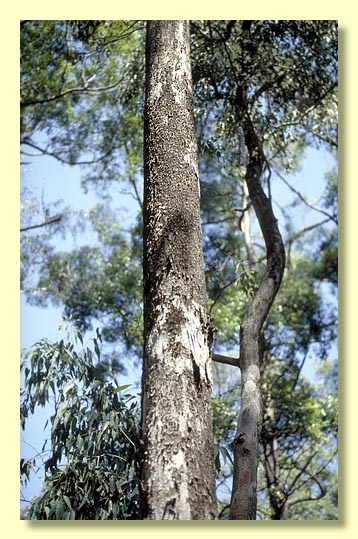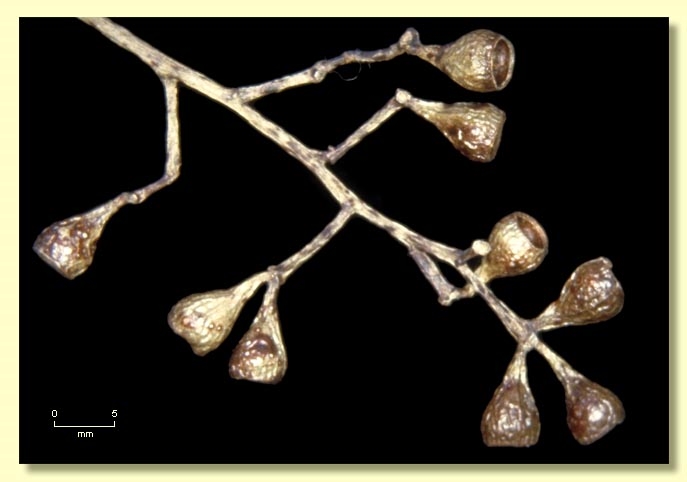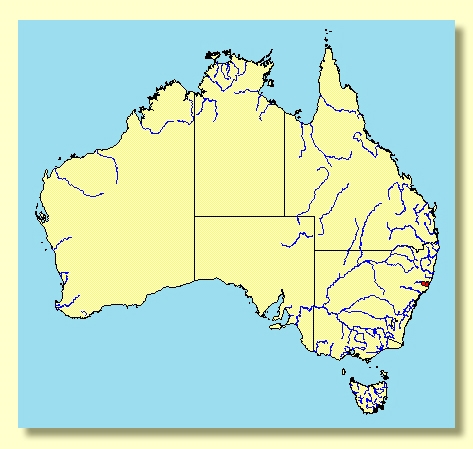Euclid - Online edition
Eucalyptus rudderi
Eucalyptus | Symphyomyrtus | Adnataria | Terminales | Heterophloiae
T: Cundletown, near Taree, NSW, July 1885, A.Rudder s.n.; lectotype: NSW135705, fide Bean, A.R., Telopea 12(4): 474 (2010).
Bark rough to small branches, box-type, often tessellated, grey to pale grey.
Juvenile growth (coppice or field seedlings to 50 cm): stems square in cross-section and slightly winged; juvenile leaves always shortly petiolate, opposite for 4 to 6 nodes then alternate, narrowly lanceolate, 3.5–5 cm long, 0.5–1 cm wide, tapering to petiole, slightly discolorous to concolorous, dull, green.
Adult leaves alternate, petiole 0.8–1.5 cm long; blade lanceolate, 7–13 cm long, 1.2–2.5 cm wide, base tapering to petiole, concolorous, green, side-veins greater than 45° to midrib, densely reticulate, intramarginal vein parallel to and just within margin, oil glands mostly island.
Inflorescence terminal compound, peduncles 0.5–1 cm long, buds 7 per umbel, pedicels 0.3–0.4 cm long. Mature buds obovoid to ovoid, ca 0.3 cm long, 0.2–0.3 cm wide, scar present, operculum conical, stamens inflexed, with outer staminodes, anthers adnate, positioned obliquely at filament tip, cuboid, dehiscing by terminal pores, style long, stigma pin-head shaped, locules 3 or 4, the placentae each with 4 vertical ovule rows. Flowers white.
Fruit pedicels 0.2–0.5 cm long, barrel-shaped or hemispherical, 0.3–0.4 cm long, 0.4–0.5 cm wide, disc descending, valves 3 or 4, near rim level, or enclosed.
Seeds brown or reddish brown, 1–1.5 mm long, ovoid or flattened-ovoid, often pointed at one end, dorsal surface pitted, hilum ventral.
Cultivated seedlings (measured at ca node 10): cotyledons reniform to oblong; stems square in cross-section, smooth; leaves always petiolate, opposite for 4 to 6 nodes then becoming alternate, lanceolate, 3.6 cm long, 0.5–2 cm wide, base tapering, margin entire, apex pointed, discolorous, mid-green above, slightly paler beneath.
Flowering has been recorded in March and April.
A small to tall, erect, forest box tree of restricted coastal distribution in New South Wales in the Taree–Karuah area. It has grey box bark. Concolorous leaves distinguish it from the closely related E. hypostomatica. It differs from other box species from the coastal area north of Sydney, E. moluccana, E. largeana and E. rummeryi, which have irregularly flexed stamens all of which are fertile. On the tablelands to the west of the distribution of E. rudderi the related box species, E. magnificata, occurs, which differs in the ovate to broadly lanceolate adult leaves and glaucous buds.
Eucalyptus rudderi belongs in Eucalyptus subgenus Symphyomyrtus section Adnataria because the buds have two opercula, ovules are in four rows, seeds are flattened-ovoid, cotyledons are reniform, and anthers are rigid on the staminal filaments. Within section Adnataria, E. rudderi is part of series Heterophloiae having box bark, terminal inflorescences, buds that shed the outer operculum early, stamens inflexed and the outer stamens sterile (staminodes). Other species in this series are E. hypostomatica from sandstone areas west of Sydney north to Wattagan State Forest, E. baueriana and E. polyanthemos in southern New South Wales and eastern Victoria, E. magnificata from the northern tablelands of New South Wales, E. conica from the slopes and adjacent tableland areas of New South Wales north from the Weddin Mountains to central Queensland, and E. fasciculosa from far western Victoria and adjacent parts of South Australia. An eighth species in the series, E. lucens, is found only west and south-west of Alice Springs.










